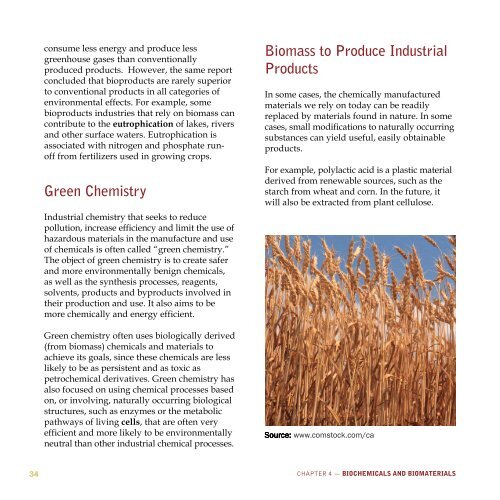c<strong>on</strong>sume less energy and produce lessgreenhouse gases than c<strong>on</strong>venti<strong>on</strong>allyproduced products. However, the same reportc<strong>on</strong>cluded that bioproducts are rarely superiorto c<strong>on</strong>venti<strong>on</strong>al products in all categories ofenvir<strong>on</strong>mental effects. For example, somebioproducts industries that rely <strong>on</strong> biomass canc<strong>on</strong>tribute to the eutrophicati<strong>on</strong> of lakes, riversand other surface waters. Eutrophicati<strong>on</strong> isassociated with nitrogen and phosphate runofffrom fertilizers used in growing crops.Green ChemistryIndustrial chemistry that seeks to reducepolluti<strong>on</strong>, increase efficiency and limit the use ofhazardous materials in the manufacture and useof chemicals is often called “green chemistry.”The object of green chemistry is to create saferand more envir<strong>on</strong>mentally benign chemicals,as well as the synthesis processes, reagents,solvents, products and byproducts involved intheir producti<strong>on</strong> and use. It also aims to bemore chemically and energy efficient.Green chemistry often uses biologically derived(from biomass) chemicals and materials toachieve its goals, since these chemicals are lesslikely to be as persistent and as toxic aspetrochemical derivatives. Green chemistry hasalso focused <strong>on</strong> using chemical processes based<strong>on</strong>, or involving, naturally occurring biologicalstructures, such as enzymes or the metabolicpathways of living cells, that are often veryefficient and more likely to be envir<strong>on</strong>mentallyneutral than other industrial chemical processes.Biomass to Produce IndustrialProductsIn some cases, the chemically manufacturedmaterials we rely <strong>on</strong> today can be readilyreplaced by materials found in nature. In somecases, small modificati<strong>on</strong>s to naturally occurringsubstances can yield useful, easily obtainableproducts.For example, polylactic acid is a plastic materialderived from renewable sources, such as thestarch from wheat and corn. In the future, itwill also be extracted from plant cellulose.Source:www.comstock.com/ca34CHAPTER 4 — BIOCHEMICALS AND BIOMATERIALS
Similar to c<strong>on</strong>venti<strong>on</strong>al fossil fuel-based plastics, polylactic acid isdurable and can be shaped and moulded to create a number ofuseful products, ranging from grocery bags to toys. It can be usedas a textile and can readily replace nyl<strong>on</strong>, polyester and polystyrene.Plastics made from petroleum products are resp<strong>on</strong>sible forworldwide landfill and other polluti<strong>on</strong> problems. While polylacticacid plastics are also slow to degrade in the envir<strong>on</strong>ment, work isbeing d<strong>on</strong>e to blend this material with cornstarch or resin to makeit more biodegradable, according to the US Department ofAgriculture. These plastics require far less energy to produce thanc<strong>on</strong>venti<strong>on</strong>al plastics. Researchers are also studying ways toproduce polylactic acid from tough stems, husks and woodyleftovers (i.e., cellulose) from farming and forestry.Enzymes as Industrial AgentsEnzymes are large, organic helper molecules that assist and speedup the chemical reacti<strong>on</strong>s necessary for life. These (mainly) proteincatalysts grab the chemicals involved in a reacti<strong>on</strong> and bring themtogether, letting go again when the desired reacti<strong>on</strong> has occurred.In some cases, industry has been able to isolate these chemicalmatchmakers from the plants, animals and micro-organisms inwhich they naturally occur, and to put them to work. Enzymescan carry out very specific tasks, so enzyme-mediated chemicalprocesses can be highly efficient. Some enzyme-mediatedprocesses use less energy and produce less waste thanc<strong>on</strong>venti<strong>on</strong>al industrial chemistry.Through genetic engineering or by “molecular evoluti<strong>on</strong>” (i.e.,rapidly “evolving” enzymes through a process that imitatesnatural evoluti<strong>on</strong> and selecti<strong>on</strong>), industry can modify and directthe work of enzymes to help with entirely new chemical reacti<strong>on</strong>sor to work in specific c<strong>on</strong>diti<strong>on</strong>s, such as high temperatures andhigh acidity.Enzymes at WorkThe global market for industrialenzymes is valued at more than $1billi<strong>on</strong> annually, according to the OECD.It c<strong>on</strong>tinues to grow by about 10 percent per year. Increasingly, enzymesare playing a pivotal role in industrialprocesses around the world.Right now, for example, enzymes canoften be found in laundry detergentto better remove stains. They arealso used to c<strong>on</strong>vert cellulose tosugar, to bleach paper, to curdlemilk for cheese, and to improve thec<strong>on</strong>sistency of flour in bread making.Iogen Corporati<strong>on</strong> (<strong>Canada</strong>) —Ottawa-based Iogen Corporati<strong>on</strong>has developed an enzyme hydrolysistechnology that readily breaks downcellulose — the tough, woody materialfound in straw, corn stalks, woodand orchard trimmings — so that itcan be c<strong>on</strong>verted to bioethanol fuel.Ethanol from biological sources hasbeen promoted as a fuel alternativethat can help reduce the greenhousegas emissi<strong>on</strong>s associated withgasoline. One problem has beenthat the <strong>on</strong>ly easy way to getethanol from plants is to c<strong>on</strong>vert itfrom starchy plants, such as cornand grain. Iogen, which has built asubstantial business developingnovel industrial uses for naturalenzymes, is now able makeenvir<strong>on</strong>mentally friendly fuel fromthe parts of food crops traditi<strong>on</strong>allyunderused or aband<strong>on</strong>ed in thefields. Iogen’s dem<strong>on</strong>strati<strong>on</strong>-scaleplant for producing “EcoEthanol” canPRIMER ON BIOPRODUCTS35
















